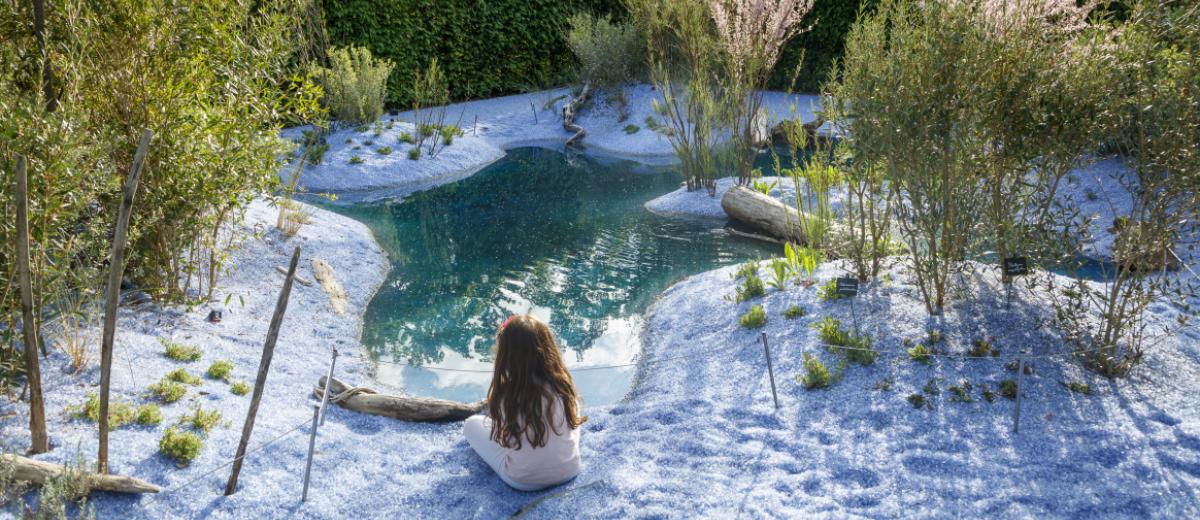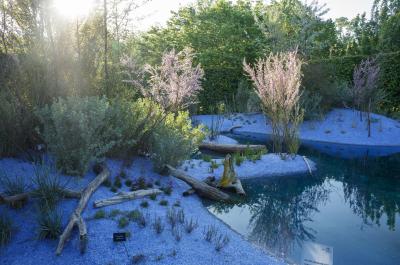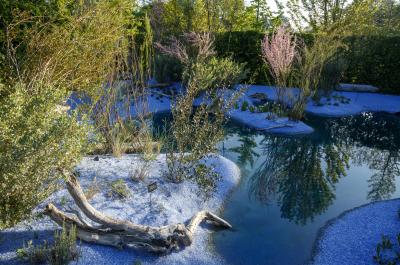14. Le chant du sel
The song of salt
Awarded on the 21st of June 2023 by a jury of professionals renowned in the world of garden art

Rising sea levels threaten communities and ecosystems across the world, with conservative estimations predicting a rise of at least 60 centimetres by 2100. The most frequent response to this problem has been to keep our cities, fields and communities out of reach. But what if, on the contrary, we learned to coexist with salt water instead of keeping it at bay? Le Chant du Sel (The Song of Salt) is a garden entirely composed of plants that have adapted to high levels of salinity – also known as halophile plants. Planted on hillocks, they divide up space, orchestrating a dynamic harmony between land and water. Two ecosystems are represented: saltmarsh and coastal dune.
The message is simple enough. Resilience – a system’s capacity to adapt to change – is often understood as a strengthening of its defences. But there’s another more sustainable, fascinating and diversified way. Instead of cutting ourselves off from the world, we can work with the forces of intelligence and nature. Le Chant du Sel is one of our halophyte friends. More than just a haven of sensory pleasure, the garden proposes a practical, creative form of adaptation to the climate crisis.
DESIGNERS

Félix de Rosen is a French designer and author, living in Oakland, California. Trained as a landscape architect, his approach to work is characterized by the Navajo word Hozho, or the joy of being a part of the beauty of all creation. His work takes many forms, from gardens to books and cultural events. His main intent is to cultivate a sense of connection with our polychromatic world. He has a bachelor's degree in political science from Harvard University and a master of landscape architecture from UC Berkeley. His first book, A Garden’s Purpose, is a series of photographic essays reimagining what gardens are. He loves swimming in water bodies, collecting seeds, and organizing parties for his community.
Éric Futerfas is an environmental designer based in Berkeley, California. He obtained a MS in Architecture from UC Berkeley where he studied building science, technology, and sustainability. In studying the built environment, he's grown more considerate of the natural environment in admiration of its complex forms and functions. In response to the climate emergency, Éric's work strives to utilize living and sustainable materials in environmentally and culturally critical ways, deploying technology to create bridges with nature rather than boundaries. He currently works as a sustainability consultant at Atelier Ten in San Francisco where he focuses on daylighting, ecosystem services, and life cycle assessments, helping to transform the built environment into a more hospitable place for all forms of life.
Bruno Derozier has lived on Île de Ré for 35 years. After taking an 18-month course as a nurseryman in Lot-et-Garonne, he set up his own business, La Criste Marine, acquiring a piece of land in Ars en Ré. He gradually planted it with species adapted to the environment, so becoming a specialist in drought-tolerant and seaside plants. He markets them directly in his nursery as well as via exhibitions on the west coast of France, in which he participates several times a year. Over the course of time, and with his wife’s assistance, the nursery on their land has become a real garden where customers and walkers enjoy strolling and assimilating the uniqueness of the spot they have created. They have also installed two greenhouses in which they clone their selection of plants. 4 years ago, they also purchased a plot of farmland in the municipality of Ars en Ré in order to provide a suitable setting for their parent plants and eventually create a second garden. As a result, they now have a collection of some 350 taxa adapted to the local environment, a wide variety of plants that enables him to carry out his activity as a nurseryman in parallel with that of garden creation.


